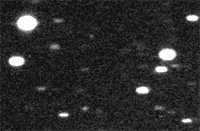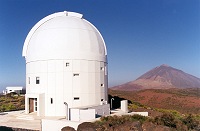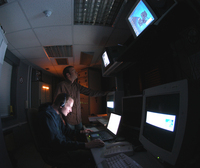Amateur discovers near Earth asteroid in ESA-sponsored survey |
For the first time, observations coordinated by ESA's space hazards team have found an asteroid that comes close enough to Earth to pose an impact threat. The space rock was found by amateur astronomers, highlighting the value of 'crowd-sourcing' to science and planetary defence.
The discovery of asteroid 2011 SF108 was made by the volunteer Teide Observatory Tenerife Asteroid Survey (TOTAS) team during an observation slot sponsored by ESA's Space Situational Awareness (SSA) programme in September.
The four-night survey used the 1m-aperture telescope at ESA's Optical Ground Station at Teide on Tenerife in the Canary Islands.
This is not the first asteroid found under SSA sponsorship, but it is the first that qualifies as a 'near Earth object' – an object that passes close enough to Earth during its orbit around the Sun that it could pose an impact threat.
Images require human evaluation
During TOTAS observations, the telescope runs automated asteroid surveys for several hours using software developed by amateur astronomer and computer scientist Matthias Busch from the Starkenburg Amateur Observatory in Heppenheim, Germany.
However, potential sightings must still be evaluated by humans.
The team comprises 20 volunteers, most of whom took part in the manual evaluation of images captured during the session on 28/29 September.
Optical Ground Station (OGS) building, Tenerife |
"Images are distributed to the entire team for review, and any one of them could be the discoverer of a new asteroid," says Detlef Koschny, Head of NEO activity for SSA. "This time, the luck of the draw fell to Rainer Kracht."
"As volunteer work, it is very rewarding. When you do spot something, you contribute to Europe's efforts in defending against asteroid hazards."
The orbit of asteroid 2011 SF108 brings it no closer than about 30 million km to Earth – a safe distance.
| ||
"The discovery was only possible with the excellent software developed by Matthias Busch, who also spotted this object in the images on the second night and sent the observations to the Minor Planet Center."
To date, some 8000 NEOs have been discovered worldwide but many thousands more are suspected to exist, particularly in the size of metres to hundreds of metres. It is important to find and track these to determine if any pose an impact threat to Earth.
Control room at ESA's Optical Ground Station, Tenerife |
TOTAS is helping to lay the foundation for a future European asteroid survey as part of the full SSA programme, which is to be decided in 2012.
Such a survey would use multiple 1m telescopes to scan the complete sky every night, a much larger effort than at present, and is expected to discover several NEOs per week. It would use a mix of professional and 'crowd-sourced' astronomers.
Currently, professional asteroid surveys are performed only in the USA. The only significant asteroid survey in Europe now is the La Sagra Sky Survey, undertaken by amateur astronomers in southern Spain.



IMPORTANT NOTICE TO ALL THAT LIVE BY THE SEA OR OCEAN SHORE AT 1 FOOT TO 50 FEET ABOVE SEA LEVEL. Or with in ten miles of the coast. World Wide.
ReplyDeleteThis will be a very close call i pray it is only that. Discovered on December 28, 2005 by Robert McMillan of the Spacewatch Program A potentially hazardous Asteroid known as 2005 YU55.
This Asteroid some what Large 400 meter-sized type – C, will pass by the Earth right between our moon and Earth. On November 8, 2011.
The people on Earth have not seen a Asteroid of this size in advance. One this big Has not impacted Earth in over at least 4 thousand years.
Most Objects that have a diameters over 45 meters or 147.637 ft strike the Earth approximately once every thousand years or so. Lying flat everything for hundreds of miles.
Like the TUNGUSKA 1908 SIBERIA, RUSSIA CRASH OR Tunguska Explosion. This one did not even hit the Earth with its full Impact, it burst high in the air above the ground plowing it apart into many smaller parts. Making thousands of very deep holes in the Russian forests. Many of them in dense forest far from any roads or towns.
One 400 Meters 1,312.3 ft in diameter like this one YU55 weighing millions of tons would if impacted Earth on land would darken all of the Earth not for just days but much longer.
It would change the weather not seen on Earth in over thousands of years a massive climate change to say the least.
Asteroids in our Asteroid Belt that is between the orbits of Jupiter and Mars do have collisions and some do turn into meteoroids many in the past thousands of years have come into the Earth's Atmosphere. Many of thousands of them make it into Meteorites the signs are all over the Earth, craters of all sizes.
Now Earth going through a Debris Field or Tail of a Comet or large Asteroid at almost the same time as Asteroid YU55 near Earth Miss? Debris fields some times are very Large to say the least.
The World and NASA will watch Outer Space very closely the next 30 days.
Most likely more Earthquakes and the Oceans Tide will be strongly affected just from a near miss. The Gravitational Effects from this event will most likely effect Earth for days.
The Lord’s Little Helper
Paul Felix Schott
Let us all pray
this is just a near Earth miss or NEO (Near Earth Object) or Near Earth Orbit.
READ THE BIBLE
Judgment Day will come soon enough.
Please Look at this site it is NASA's Near Earth Object Program.
neo.jpl.nasa.gov/ca/
UP COMING CLOSE APPROACHES TO EARTH
Then go to
(2009 TM8) OCT16,2011
(2005 YU55) NOV8, 2011
(2000 YA) DEC 26, 2011
May The Lord GOD our Father in Heaven Watch over and Guide you.
GOD Bless
Read the Bible